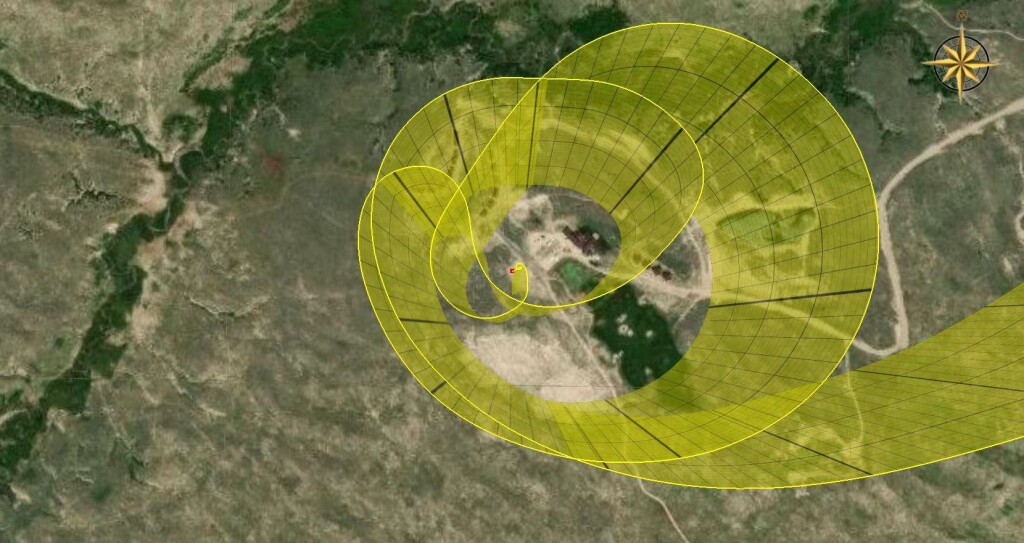Unanticipated Yaw: Loss of Control During Landing Site Survey (Airbus EC130T2, N130TG)
On 3 August 2018 private Airbus Helicopters EC130T2 N130TG lost control while manoeuvring to survey a potential landing site near the Dismal River Golf Club at Mullen, Nebraska. The pilot was uninjured, but the passenger sustained serious injuries and the helicopter was substantially damaged.
The US National Transportation Safety Board (NTSB) explain in their safety investigation report that the 61-year-old pilot had just 213 total flying hours, 80 as PIC and 194 on type.
The pilot reported the weather was clear and breezy with 15 to 20 knots of wind from the southeast. As the helicopter approached the golf course the helicopter was about 500 ft above the ground, 100 knots, and slowing to 70 knots as he initiated a descent.
Evidence from the installed Appareo Vision 1000 image, audio, and data recorder was examined by the NTSB and proved valuable in understanding the accident:
The helicopter entered a right turn around a group of buildings. A flagpole visible in the video indicated that the winds were out of the south; the flag was mostly unfurled, and the flag was fully visible.
After one right turn, the helicopter started a left turn around the same group of buildings.
EC130T2 N130TG Vision 1000 Data: A north-up overview depiction of the helicopter’s flight path in the region of the accident (Credit: NTSB)
As the turn begins to tighten in radius the helicopter starts to descend.
EC130T2 N130TG Vision 1000 Data: the helicopter’s flight path arranged in a way to show the helicopter’s descent profile and turn radius just prior to the loss of yaw control. Note that the data is not truthed to actual ground level (Credit: NTSB)
The ground speed showed a decreasing trend with an indicated airspeed of 30 knots. The heading changed to north, the ground speed decreased, and the airspeed indicator displayed 0 knots. As the helicopter turned to a downwind condition, a left yaw rate rapidly increased and was not arrested, resulting in a loss of yaw control.
The pilot stated that he initially added right-pedal during the first ½ of the turn and increased it to full right pedal for the remainder of the rotation.
According to the data analysis:
At the moment of loss of yaw control, the First Limit Indicator (FLI) read about 6.5 units, the pitch was nose down (about -18 degrees) and quickly became more nose down as the loss of yaw control continued. The pilot made some aft stick inputs around this time. There was a slight right pedal input observed, the right pedal was forward of the left pedal about an inch. As the loss of yaw control continued to develop, the pilot made a slight left pedal input. The helicopter continued yawing to the left and remained nose down (-18 degrees). The left pedal remained slightly forward of the right pedal until the time of ground impact. From the time of the loss of yaw control, the helicopter completed about 1.25 rotations to the left until ground impact.
The fuselage and main rotor were damaged on impact.
Reflectively, the pilot commented that…
…he needed to perform higher, faster, and wider turns.
He told the NTSB he “had encountered similar rotations before but was always able to recover”.
The pilot was not familiar with the service letter from Airbus [see Safety resource below]. He had completed their course in May at their facility in Grand Prairie, Texas, and he recalled discussion regarding loss of tail rotor control.
NTSB Probable Cause
The pilot’s inadequate and incorrect anti-torque pedal application during a tight, decelerating turn downwind, which resulted in a loss of yaw control.
Safety Resources: Unanticipated Yaw
NTSB note that:
In February 2005, Eurocopter released Service Letter No. 1673-67-04 “Reminder concerning the YAW axis control for all helicopters in some flight conditions” and specifically addressed the operational differences between the Fenestron and the conventional tail rotor. In July 2019, Airbus Helicopters released Safety Information Notice No. 3297-S-00 “Unanticipated left yaw (main rotor rotating clockwise), commonly referred to as LTE” and specifically addressed the characteristics of the unanticipated yaw, and how pilots can respond to avoid or reduce the effect of the unanticipated yaw.
Airbus have discussed unanticipated yaw phenomena and the ‘myth of LTE’ here:
Other Safety Resources
The European Safety Promotion Network Rotorcraft (ESPN-R) has a helicopter safety discussion group on LinkedIn. You may also find these Aerossurance articles of interest:
- Grand Canyon Air Tour Tragic Tailwind Landing Accident
- Inexperienced IIMC over Chesapeake Bay: Reduced Visual References Require Vigilance
- CFIT Gangnam Style – Korean S-76C++ and Decision Making
- That Others May Live – Inadvertent IMC & The Value of Flight Data Monitoring
- US Air Ambulance Near Miss with Zip Wire and High ROD Impact at High Density Altitude
- BK117 Impacts Sea, Scud Running off PNG
- Fatal Wisconsin Wire Strike When Robinson R44 Repositions to Refuel
- Impromptu Landing – Unseen Cable
- Hanging on the Telephone… HEMS Wirestrike
- Air Ambulance Helicopter Downed by Fencing FOD
- Ambulance / Air Ambulance Collision
- A Try and See Catastrophe: R44 Accident in Norway in Bad Weather
- NTSB Investigation into AW139 Bahamas Night Take Off Accident
- Fatal B206L3 Cell Phone Discount Distracted CFIT
- Fatal Helicopter / Crane Collision – London Jan 2013
- Tragic Texan B206B3 CFIT in Dark Night VMC
- Fatal R44 Loss of Control Accident: Overweight and Out of Balance
- Latent Engine Defect Downs R44: NR Dropped to Zero During Autorotation
- Helicopter Destroyed in Hover Taxi Accident
- Fatal US Helicopter Air Ambulance Accident: One Engine was Failing but Serviceable Engine Shutdown
- UPDATE 5 March 2021: Wire Strike on Unfamiliar Approach Direction to a Familiar Site
- UPDATE 21 May 2021: Firefighting AW139 Loss of Control and Tree Impact
- UPDATE 21 December 2021: R44 Unanticipated Yaw Accident During Tailwind Take Off Caught on Video




Recent Comments